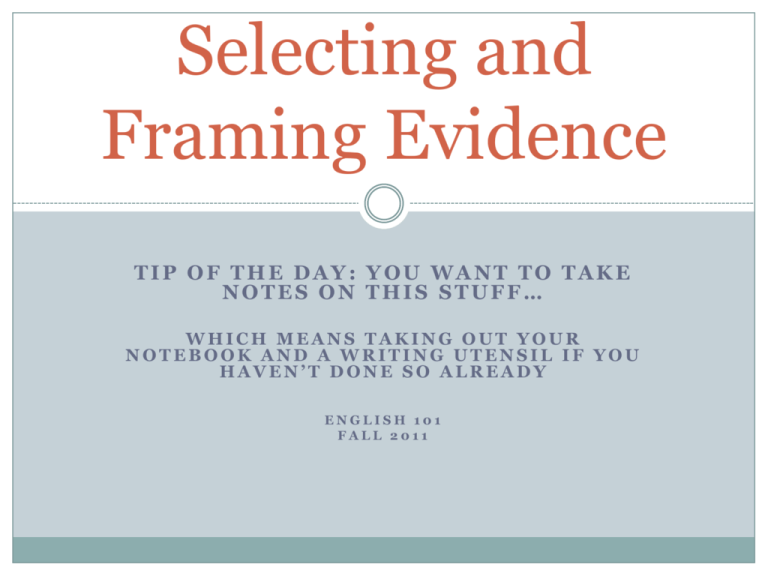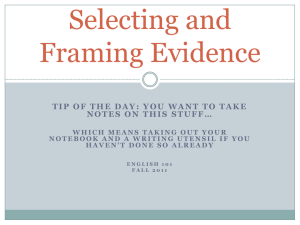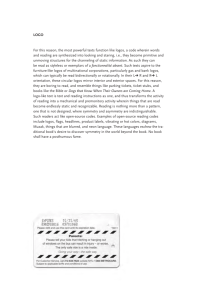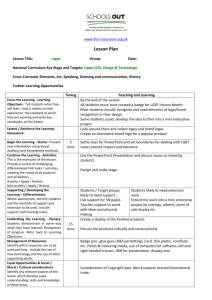Framing Evidence PowerPoint
advertisement

Selecting and Framing Evidence TIP OF THE DAY: YOU WANT TO TAKE NOTES ON THIS STUFF… WHICH MEANS TAKING OUT YOUR NOTEBOOK AND A WRITING UTENSIL IF YOU HAVEN’T DONE SO ALREADY ENGLISH 101 FALL 2011 What is going on in this picture? Where is this happening? When is this happening? Why is this happening? What information do we still need? Is this a good trip or a bad trip? Do you think the sailors are having a bad day? Frames determine what is seen and unseen. As writers, you are in control of how evidence is framed. What do you want to emphasize? What should be left out? What can you leave out while still being an ethical writer? Is there anything wrong with this caption? Fresh fish from the sea caught daily Your angle of vision will help determine how you frame evidence. It’s like looking through a peep hole or camera lens. As a writer, “you maximize the reader’s focus on some data, minimize the reader’s focus on other data, and otherwise [guide] the reader’s vision and response” (96). What influences your angle of vision? Age Marital status Gender Cultural or ethnic background Class Education level Personal history Selecting and framing evidence are two ways to use logos to create an angle of vision. What is logos again? “focuses attention on the quality of the message—that is, on the internal consistency and clarity of the argument itself and on the logic of its reasons and support” (62) How do you think logos affects the quality of a message? Why do you think logos is connected to “selecting and framing evidence?” Let’s practice creating an angle of vision by selecting evidence. Turn to page 96 in your textbook. Your task as a group is to compose a short speech either in favor of or in opposition to a city ordinance to ban mosh pits. I will assign each group a position (for or against). You have ten minutes to complete this task. Use the provided list of evidence on pages 96-97 to compose your speech. Group Roles: Timekeeper: Make sure your group manages its time. Scribe: Take notes on behalf of the group. Whip: Make sure your group stays on task. Orator: You will present the finished speech to the class. There are different ways to effectively frame evidence. Controlling the space given to supporting versus contrary evidence. When composing your speeches, did you choose to use more evidence to support your position or to refute it? Why? Emphasizing a detailed story versus presenting lots of facts and statistics. When might we privilege one strategy over the other? Providing contextual and interpretive comments when presenting data. Can the data speak for itself? Putting contrary evidence in subordinate positions Some subordinate conjunctions: although, even though, rather than, though, whereas, while How does Leonhardt frame evidence? Pull out your copy of Controlling the space given Leonhardt’s editorial. Read through it individually and mark where he presents evidence and how it is framed. (5 minutes) Compare your findings with your group mates and then be prepared to share them with the class. to supporting versus contrary evidence. Emphasizing a detailed story versus presenting lots of facts and statistics. Providing contextual and interpretive comments when presenting data. Putting contrary evidence in subordinate positions. Always think about how you frame statistics. As you watch this video, Turn to page 101 in your note which statistics are used: http://www.youtube.co m/watch?v=Y7GGwg194 9A Why say 1 in 166? The odds of your child being diagnosed with autism? .06 % textbook. Let’s come up with different ways to frame the evidence about the ballpark. Evidence is tied to logos. Evidence Ethos Logos Pathos




